How Much Exercise Does an Australian Shepherd Puppy Need?
Australian Shepherd puppies are known for their intelligence, energy, and agility. Exercise plays a vital role in their overall well-being, as it helps keep their mind active and their body strong. Ensuring that your Aussie puppy gets the right amount of exercise is crucial for their growth, development, and happiness.
While every puppy is different, Australian Shepherds, as a breed, typically require a significant amount of exercise to thrive. On average, these pups need at least an hour of physical activity per day, which can include walking, running, playing fetch, or engaging in various dog sports. Keep in mind that this is just a baseline, and some Aussie puppies may require more or less exercise depending on their individual needs.

As your Australian Shepherd puppy grows, it’s essential to monitor and adjust their exercise routine accordingly. Be sure to watch for signs of fatigue or overexertion, and always provide mental stimulation in addition to physical activities. By keeping a close eye on your pup, you can ensure they develop into a happy, healthy, and well-adjusted adult dog.
Understanding Australian Shepherd Puppy Exercise Needs
Australian Shepherd puppies are energetic, intelligent, and require a good amount of exercise to keep them healthy and happy. It is crucial for owners to understand their puppy’s exercise needs, as this helps in proper growth and prevents various behavioral issues.
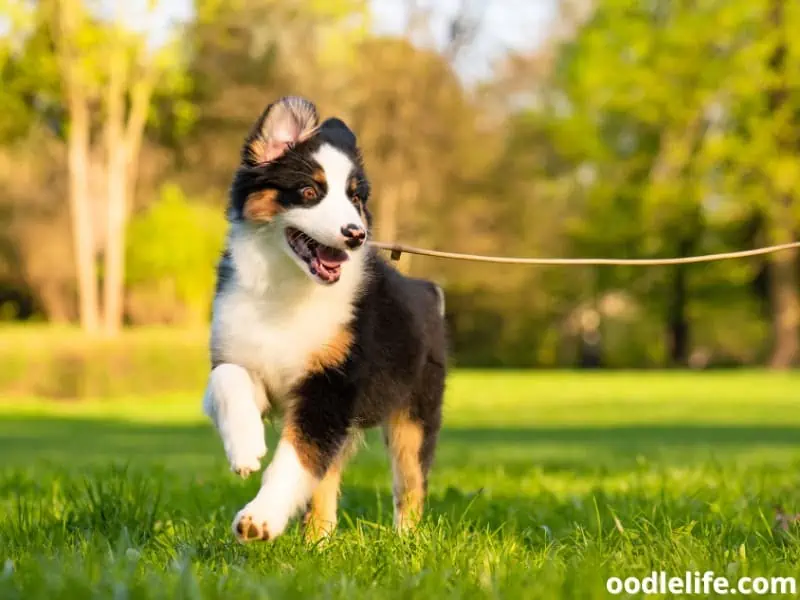
Typically, an Australian Shepherd puppy needs around 30-60 minutes of exercise daily, which can be increased as they grow older. Activities can include walking, running, playing fetch, or agility training. Keep in mind that these puppies are quick learners, so incorporating mental stimulation into their exercise routine is also essential.
This can be done through puzzle toys or incorporating basic obedience commands in their playtime.
Remember that over-exercising young puppies can cause damage to their developing joints, so it’s essential to monitor their energy levels closely. Break the exercise sessions into smaller intervals throughout the day and pay attention to your puppy’s body language. If they are panting excessively, limping or showing signs of fatigue, it’s time to take a break.
Socialization plays a vital role in a puppy’s overall development and behavior. Make sure your Australian Shepherd puppy interacts with other dogs, people, and gets exposed to various environments. This will help them become better-rounded and more adaptable in different situations.
Lastly, don’t forget to have fun with your Australian Shepherd puppy! Their enthusiasm and cleverness make them great playmates, and spending quality time with them will help strengthen the bond between you and your furry friend. Keep the exercises fun and engaging, so both you and your pup look forward to the daily exercise routines.
Happy exercising!
Daily Exercise Requirements for Australian Shepherd Puppies
Physical Exercise
Australian Shepherd puppies are energetic, intelligent, and active dogs that need consistent physical exercise to maintain their health and happiness. Aim for one to two hours of physical exercise per day, depending on your puppy’s age and energy level. It’s essential to adjust the exercise routine based on the dog’s development and gradually increase the intensity and duration as your puppy grows.
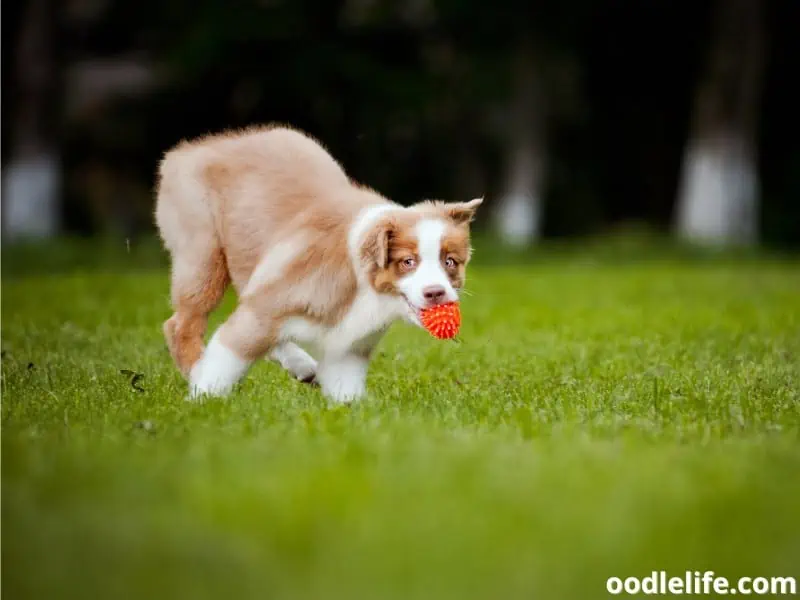
Short walks and playing sessions are great ways to start, and as your puppy grows older, you can begin to introduce more organized activities such as:
- Fetching games: Tossing a ball or a frisbee will keep your Australian Shepherd engaged and entertained.
- Agility training: Introducing your puppy to agility courses helps to build their strength, endurance, and coordination.
- Off-leash play: Allowing your Australian Shepherd to run around and explore in a safe, enclosed space will provide both physical and mental stimulation.
Remember always to keep exercise sessions fun and engaging to encourage your puppy’s natural enthusiasm and love for exercise.
Mental Exercise
In addition to physical activities, Australian Shepherd puppies benefit from mental stimulation to keep their intelligent minds challenged. A mentally exercised dog is less likely to exhibit destructive behaviors and will maintain a better overall temperament.

Here are a few activities to help stimulate your puppy’s mind:
- Puzzle toys: Invest in some interactive toys that require your puppy to think and solve problems to access treats or rewards.
- Obedience training: Teaching basic commands like sit, stay, and come not only helps with behavioral management but also keeps your puppy’s mind engaged.
- Nose work: Engaging your Australian Shepherd’s keen sense of smell will provide mental stimulation and strengthen their natural instincts.
By incorporating both physical and mental exercises into your daily routine, you’ll help ensure your Australian Shepherd puppy grows into a well-rounded, happy, and healthy adult dog.
Age-Appropriate Exercises
8 Weeks to 4 Months Old
At this early age, Australian Shepherd puppies are in the process of learning and discovering their surroundings. Their exercise should focus on gentle play and short walks in secure areas away from dangers.
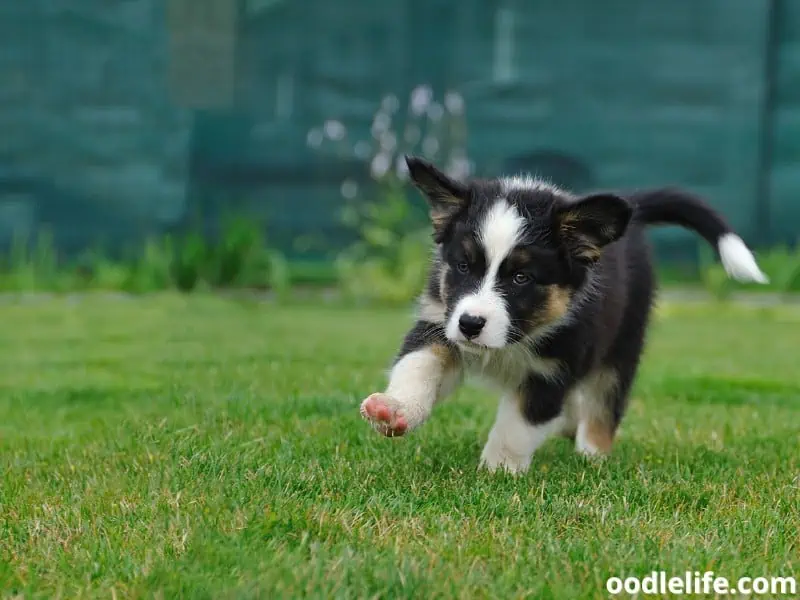
This could include:
- Playing fetch with soft toys for 5-10 minutes
- Gradually increasing walk durations from 5 to 15 minutes
- Basic obedience training (e.g. sit, stay, come)
Remember to keep an eye on their energy level to avoid overexertion. Puppies at this age should be encouraged to explore and interact with their environment, building their confidence and bond with their owners.
4 Months to 9 Months Old
In this phase, the Australian Shepherd puppy begins to develop increased energy levels and coordination. To keep them engaged and challenged, you can introduce more structured exercise and mental stimulation.
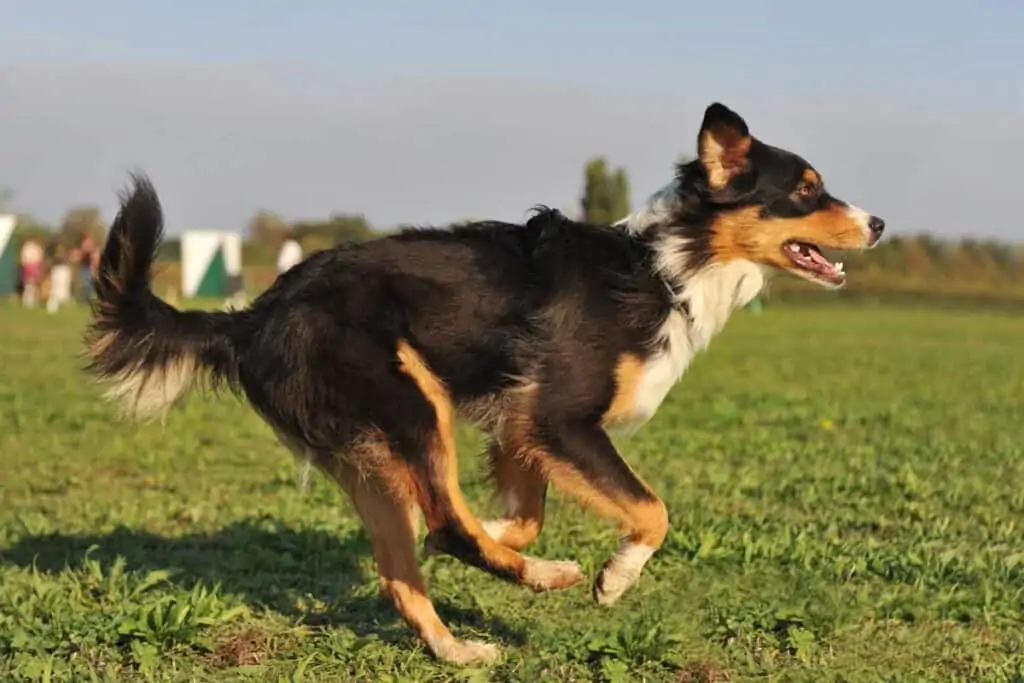
Some ideas include:
- Playing tug-of-war with appropriate toys
- Agility training using makeshift or store-bought equipment
- Continuing obedience training with more advanced commands
- Increasing walk durations to 20-30 minutes, depending on the puppy’s stamina
Always remember to provide ample rest and positive reinforcement during training. This will help maintain a happy, healthy bond between you and your pup.
9 Months to 1 Year Old
At this age, your Australian Shepherd is almost a fully grown, agile, and energetic dog. They will require more demanding exercises to keep them physically and mentally fit.
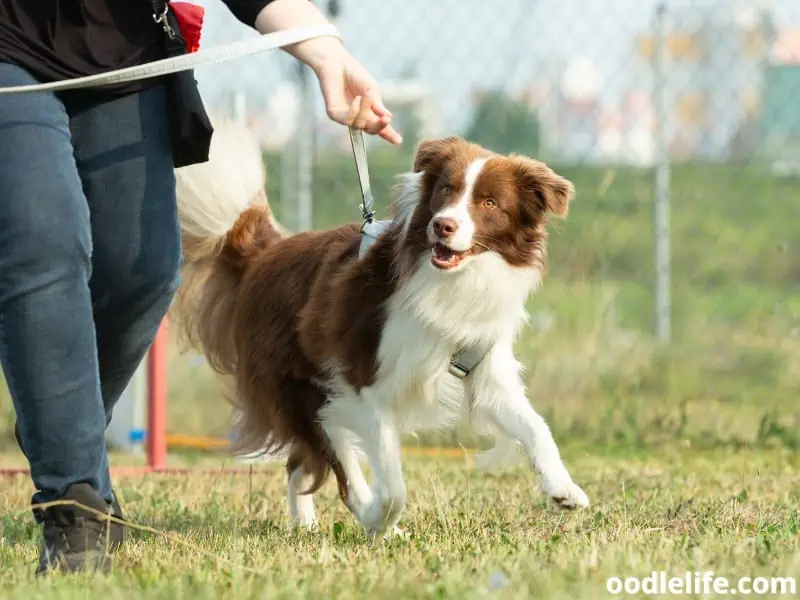
Consider the following exercises to challenge your young dog:
- Hiking on moderate trails for around 45-60 minutes
- Structured herding exercises (if you have access to livestock or herding balls)
- Advanced agility training with higher jumps and more complex courses
- Off-leash play at dog parks, ensuring proper socialization
It’s important to continue monitoring your dog’s energy levels and adjust the exercises accordingly. By providing age-appropriate exercises, you’re setting your Australian Shepherd up for a lifetime of fitness and happiness.
Avoiding Over-Exercise
Australian Shepherd puppies are known for their energy and enthusiasm, but it’s essential to avoid over-exercising them as it could lead to health issues such as joint problems and muscle atrophy. Here, we’ll discuss how you can strike the right balance when it comes to keeping your Aussie pup active and healthy.

First, understand that puppies’ energy levels can fluctuate throughout the day. It’s normal for them to have bursts of activity followed by periods of rest. Instead of focusing on a specific amount of exercise, prioritize scheduling regular playtime and short walks.
Aim for three to four 15-minute sessions daily, gradually increasing the duration as they grow older.
Puppy exercise should be low-impact and age-appropriate. Fetch games, like with a soft toy or ball, and gentle tug-of-war play can be excellent ways to engage your Aussie pups without straining their developing bodies.
Socializing with other puppies is another way to provide physical and mental stimulation. Puppy socialization classes or in-home playdates are excellent tools to teach your pup good manners and proper play behavior in a controlled environment.
Remember, a tired Aussie pup is more likely to be well-behaved. Including mental stimulation throughout the day, like training sessions and puzzle toys, can help keep their active minds occupied and help them sleep better at night.
Lastly, be patient. Australian Shepherd puppies will require more exercise as they grow, and you’ll need to adjust your routine accordingly. Listening to your puppy and adapting to their needs will help you find the perfect balance between exercise and rest for a happy, healthy pup.
Exercise Tips for Various Weather Conditions
Australian Shepherd puppies are energetic and require regular exercise to stay healthy and happy. The amount of exercise they need may vary depending on weather conditions. Let’s explore some exercise tips for your Aussie pup during various weather situations.
Sunny and Warm Days
During sunny and warm days, take advantage of the pleasant weather and consider outdoor activities like fetch and games that will keep your pup engaged. Remember to provide plenty of water and take breaks in the shade to prevent overheating.
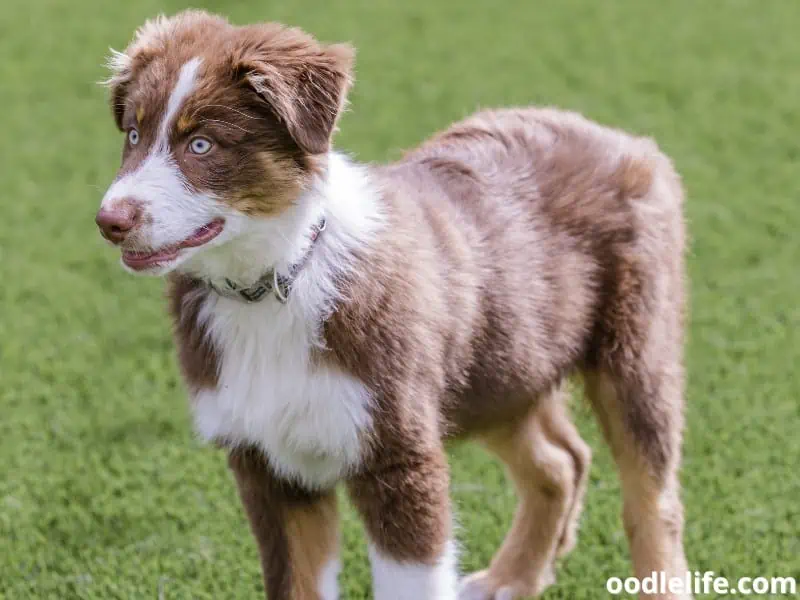
Cold and Snowy Days
When it’s cold and snowy outside, your Aussie puppy still needs exercise. Consider short walks with a cozy jacket to keep them warm. Indoor games like tug-of-war or hide-and-seek can also provide stimulation and physical activity.
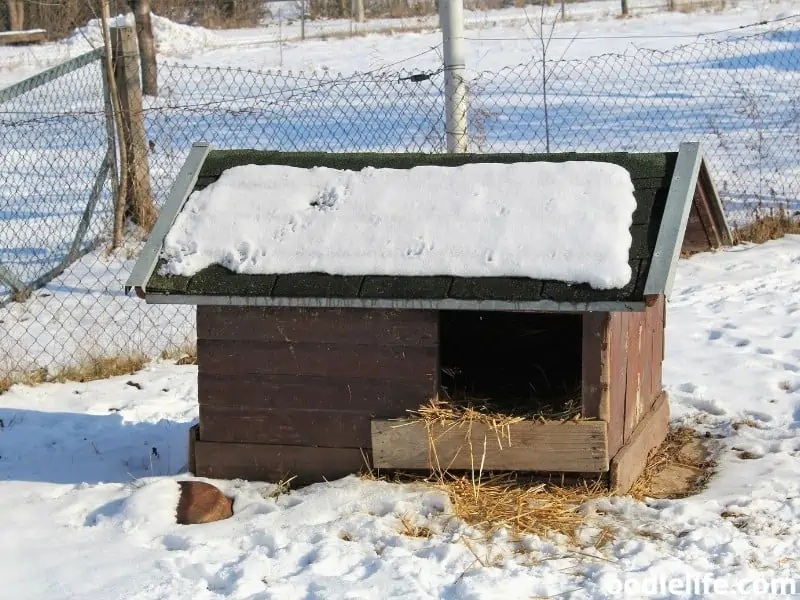
Rainy and Wet Days
A little rain shouldn’t stop you and your Australian Shepherd from getting some exercise. Equip your pup with a waterproof jacket and take a brisk walk. If going outside isn’t an option, set up obstacles courses inside to challenge your pup’s physical and mental capabilities.
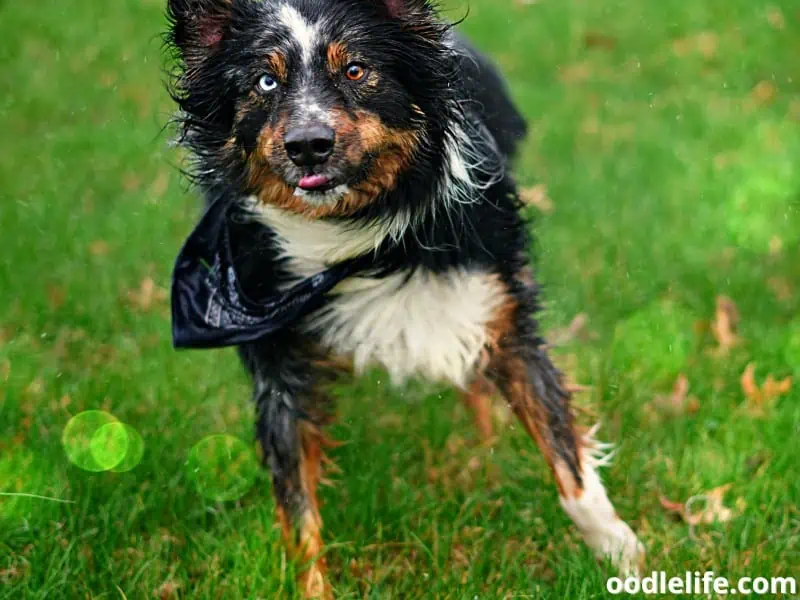
Remember, adjusting your Australian Shepherd puppy’s exercise routine based on the weather conditions is essential for their overall health and happiness. So, enjoy every season with your furry friend and stay active together!
Monitoring Your Puppy’s Health and Energy Levels
Australian Shepherd puppies are known for their high energy levels and intelligence, making it essential for owners to monitor their health and activity. Regular exercise is crucial to maintaining a healthy and happy Australian Shepherd puppy.

One effective way to assess your puppy’s energy levels is through tracking their daily activities. Use an activity monitor specifically designed for dogs, as they provide valuable insights into your puppy’s overall behavior and exercise patterns. This way, you can ensure your pup is getting enough exercise without going overboard.
Consider that a puppy’s energy levels can vary depending on factors like age, individual temperament, and overall health. Typically, younger Australian Shepherd puppies require more frequent, short bursts of exercise, while older pups might benefit from longer, more structured workouts. Pay attention to how your puppy reacts during and after exercise; if they seem overly tired or unresponsive, it might be time to adjust their routines.
It’s also vital to monitor your Australian Shepherd puppy’s health by scheduling regular vet visits. Puppies should have a series of vaccinations and check-ups during their first year of life, with semi-annual or annual appointments afterward. In addition to veterinary care, pay attention to your dog’s weight, coat condition, and behavior changes as they can indicate underlying health issues.
Lastly, don’t be afraid to tailor your puppy’s exercise regimen to their unique needs. Remember, each Australian Shepherd is different, and adjustments may be necessary as they grow and mature. By being observant and proactive, you’ll help your furry friend stay healthy, energetic, and ready for all the adventures that lie ahead.